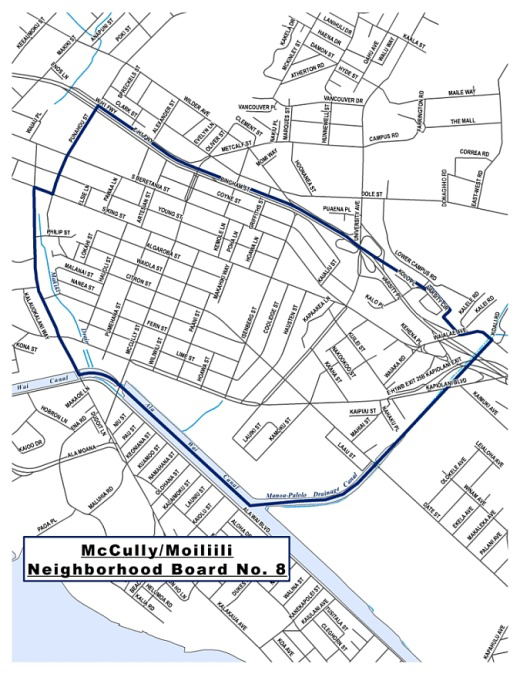
History of Mōʻiliʻili
The evolution of Mōʻiliʻili was multi-cultural and similar to how many neighborhoods in Hawai'i were established. It was initially an agrarian community, home to mostly Hawai'ians and Chinese ethnic groups who used the low lying area for growing rice, taro, bananas, and other vegetables. Later, many Japanese and Portuguese persons came to the area after leaving plantations to work in the Mōʻiliʻili Quarry. Some transitioned to become small business owners, tradespersons, and service providers. It is now an urban community with a mixture of ethnic groups, including recent immigrants who live, work and play in amongst older single family homes, apartments, and condominiums; small businesses and national retailers; and the University of Hawai'i @ Manoa (UHM).

Methodology
The McCully-Mōʻiliʻili community became the focus of the HI-CFL project in 2013-2014. The process took several months to complete. After interest from the community was confirmed, an open public gathering (Kick-Off) was held to inform residents, stakeholders, and interested community members about the HI-CFL project. A workshop followed specifically for residents to provide instruction on utilizing Mapping Attributes: Participatory Photographic Surveys (MAPPS) to survey community features by photographing and geocoding place-based characteristics. Upon completion of MAPPS, the volunteer photographers reviewed all photos and determined which illustrated significant features of their neighborhood applying the WHO physical, social, and service environments. At the final event (Community Conversation), community members viewed the selected photos, discussed, and suggested ideas for how the McCully-Mōʻiliʻili community could become a Community For a Lifetime.
Between February and March 2014, a total of 13 individuals (28 cumulative participants) including McCully-Mōʻiliʻili residents and stakeholders became involved in this project. MAPPers took 121 photos and selected 30 to discuss at the Community Conversation. Meetings were conducted at either the Mōʻiliʻili Community Center or St. Mary’s Episcopal Church.
Date
|
Meeting |
Number of Attendees |
| February 17, 2014 |
Kick Off & MAPPS Training |
9 |
| March 8, 2014 |
MAPPS Discussion |
8 |
| March 22, 2014 |
Community Conversation |
11 |
Illustration of McCully-Mōʻiliʻili Resident MAPPS Routes

Youth MAPPS
Prior to these events in October 2013, 16 teenagers photomapped the area around their school. The Iolani School “One-Mile Project” class was devoted to investigating possible service initiatives to help their local community which they defined as within one mile of their school. The high school students, under the guidance of their instructors decided to focus on the elderly and utilized HI-CFL as part of their curriculum. More information about their project is at http://www.generations808.com/fm2014i.html
Although only two of the students were McCully-Mōʻiliʻili residents, all of them participated in this HI-CFL Project as a part of their class. The student MAPPers walked the community in 2-3 person teams chaperoned by an adult during one 45 minute class period. Fifteen students took a total of 143 photos and 16 students participated in the selection of 31 pictures that they felt best described current McCully-Mōʻiliʻili features. The youth were invited to attend the Community Conversation, but none participated. However, their preferred photographs were included at that meeting and their comments are included in this Report.
| Date |
Meeting |
Number of Students |
Number of Adults |
| October 7, 2013 |
Kick Off & MAPPS Training |
16 |
2 |
| October 8, 2013 |
MAPPS Event |
15 |
6 |
| October 23, 2013 |
MAPPS Discussion/Selections |
16 |
0 |
Illustration of the Youth MAPPS Routes
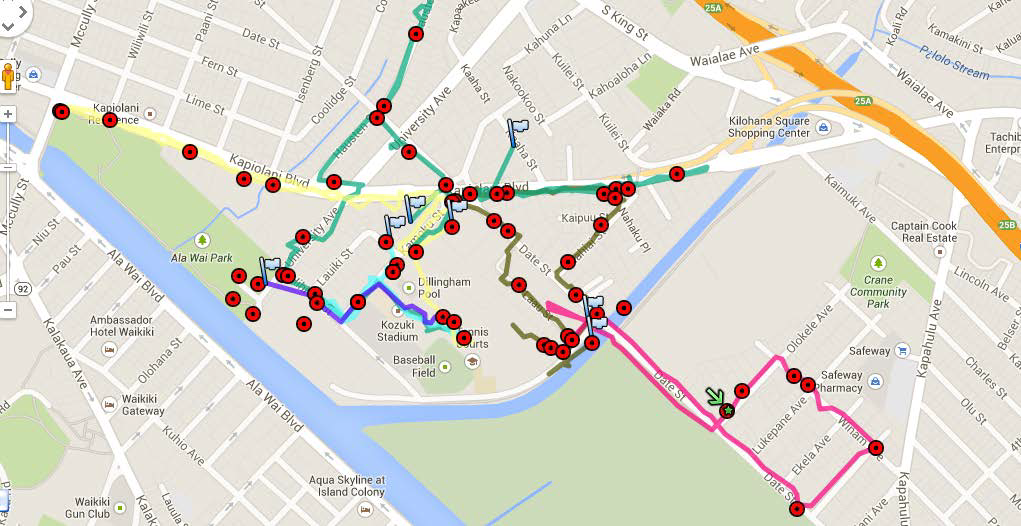
Summary of Results
With the limited number of persons involved in the project, the information provided in this Report may not reflect the views of the community as a whole. However, it offers an initial scan on the age-friendliness of the McCully-Mōʻiliʻili Community.
Is McCully-Mōʻiliʻili Age-Friendly?
“No” – 55%; “Yes” – 45% [Adults at the HI-CFL Community Conversation]
“No” – 100% [Youth after their experience with HI-CFL]
I. Physical Environment
 At the Community Conversation, 73% of the participants disagreed with the statement, “McCully-Mōʻiliʻili has a physical environment that supports physical and mental health behaviors”. The green open spaces seem to enhance a sense of well-being in this urban setting. The community has many parks and areas that provide vistas and gathering places away from traffic with walking space, park benches, and shade trees to play, breathe, and socialize for people of all ages. In addition, some of the parks offer facilities that can be used at night for meetings or recreational programs including organized sports. There are also venues that provide a cultural history of the area’s past. Often these facilities are welcoming, well utilized and maintained suitably; but others are run down, need restoration and cleaning. Other assets were mentioned as “unsightly and ghetto” including streams and canals (functionality appreciated when maintained) and UHM lower gate area.
At the Community Conversation, 73% of the participants disagreed with the statement, “McCully-Mōʻiliʻili has a physical environment that supports physical and mental health behaviors”. The green open spaces seem to enhance a sense of well-being in this urban setting. The community has many parks and areas that provide vistas and gathering places away from traffic with walking space, park benches, and shade trees to play, breathe, and socialize for people of all ages. In addition, some of the parks offer facilities that can be used at night for meetings or recreational programs including organized sports. There are also venues that provide a cultural history of the area’s past. Often these facilities are welcoming, well utilized and maintained suitably; but others are run down, need restoration and cleaning. Other assets were mentioned as “unsightly and ghetto” including streams and canals (functionality appreciated when maintained) and UHM lower gate area.
Many people mentioned that the public places were also inviting for homeless and this has become an issue. It was contemplated whether beautiful parks, open public spaces and the Homeless could coexist. There were trepidations about being able to physically utilize the facilities, sidewalks or grassy areas or be active safely. Youth labeled it “scary” and “terrifying”.
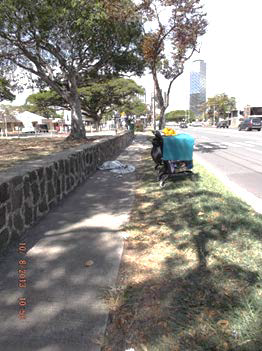 Recognizing that McCully-Mōʻiliʻili is a densely populated area, it was stated that “more people means more trash”. Multi-unit apartments do not seem to have adequate trash bins; bulky trash is an issue. People felt that this creates an unhealthy and unpleasant environment as well as a hazardous accessibility situation for people walking or driving.
Recognizing that McCully-Mōʻiliʻili is a densely populated area, it was stated that “more people means more trash”. Multi-unit apartments do not seem to have adequate trash bins; bulky trash is an issue. People felt that this creates an unhealthy and unpleasant environment as well as a hazardous accessibility situation for people walking or driving.
When asked about the statement, “In McCully-Mōʻiliʻili, people of all ages have access to various forms of transportation”, 64% of the participants agreed. Road space is shared with vehicles, bicycles, and pedestrians. There are some wide roads and a few bike lanes in the area, especially near UHM. The Bus allows for convenient transportation to all directions around the island. Recently, some stops were deleted and schedules changed. This has made it difficult for the elderly who now must walk further to get to a Bus stop. Some people felt that although the system appears to be good, improvements are needed; Bus riders should be queried about their views.
Walking safely is an important matter to residents. In the last few years, pedestrians have been aided by signage, upgraded lighting in key intersections and public crossings, and curb ramps. Many people, especially those with disabilities, strollers, wheelchairs, etc. still have challenges navigating this community. There were many concerns about sidewalks (conditions or lack of), curb ramp location, timers for crosswalks, and obstacles (bulky items, trash bins, homeless, etc.).
The majority of participants (82%) disagreed with the statement, “Outdoor spaces and building design in McCully-Mōʻiliʻili support mobility and independence”. Some buildings and parks are handicap accessible with ramps and elevators.
 Both the adults and youth mentioned that it is difficult to be physically active, obtain services, or access social events when there are obstacles. Numerous specific items were cited: poor street conditions (potholes, unpaved roads, rocky); lack of or poor sidewalk conditions (no continuity or inconsistency from one corner to another; cracked, uneven, narrow pathways, location of utility poles, cracked utility covers, overgrown foliage, blockage from trash bins, open rubbish cans, dumping of large household items, parked vehicles, or homeless), overpasses accessible only by stairs, lack of curbs, and hazardous construction. Due to high-rise condominiums and dense population, there is inadequate parking. People ignore “No Parking” signage; passenger and delivery vehicles often park on sidewalks causing people to walk in the streets.
Both the adults and youth mentioned that it is difficult to be physically active, obtain services, or access social events when there are obstacles. Numerous specific items were cited: poor street conditions (potholes, unpaved roads, rocky); lack of or poor sidewalk conditions (no continuity or inconsistency from one corner to another; cracked, uneven, narrow pathways, location of utility poles, cracked utility covers, overgrown foliage, blockage from trash bins, open rubbish cans, dumping of large household items, parked vehicles, or homeless), overpasses accessible only by stairs, lack of curbs, and hazardous construction. Due to high-rise condominiums and dense population, there is inadequate parking. People ignore “No Parking” signage; passenger and delivery vehicles often park on sidewalks causing people to walk in the streets.
People also mentioned there was a lack of shade or trees for pedestrians and no benches to sit on to rest when tired. Some thought that McCully-Mōʻiliʻili visually looks like an older community that needs lots of repair to its’ physical infrastructure and is not a “residential area”.
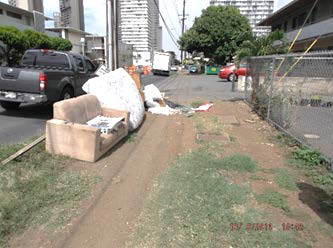 Overwhelmingly, the participants (99%) disagreed with the statement, “All McCully-Mōʻiliʻili residents have access to affordable, accessible housing options”. People have become attracted to this area because of lower rents in comparison to other locations. But, homeownership in this area is very low. The vast majority who live in McCully-Mōʻiliʻili are renters which include elderly, college students, and recent immigrants. Many are single person households.
Overwhelmingly, the participants (99%) disagreed with the statement, “All McCully-Mōʻiliʻili residents have access to affordable, accessible housing options”. People have become attracted to this area because of lower rents in comparison to other locations. But, homeownership in this area is very low. The vast majority who live in McCully-Mōʻiliʻili are renters which include elderly, college students, and recent immigrants. Many are single person households.
In this high density area, many apartments are old walk-ups or very old homes (at least 20 years old) with no handicap access. Some appear to be unsafe, rusting, and with little maintenance of common areas, raised surfaces or sidewalks. Parking is also very limited or nonexistent. Young people said that the housing was not very friendly looking.
High-rise condominiums often seem to have replaced affordable apartments and homes. When older structures become demolished, people have been displaced with few alternatives for low cost rents. The lease-to-fee conversions affect people on fixed income, forcing them to seek living options elsewhere. People wondered where do displaced residents go.
II. Social & Cultural Environment
A slight majority (64%) of the participants agreed with the statement, “McCully-Mōʻiliʻili supports active involvement, social and cultural participation, and intergenerational connectivity among all residents”. People mentioned many good places in McCully-Mōʻiliʻili for children, families, and elderly. Numerous organizations (government, non-profit and for profit) provide a variety of activities for preschoolers to older adults such as the City’s parks programs, Mōʻiliʻili Community Center, schools, churches, etc. As an older community, there are a lot of historical and cultural sites such as the Honolulu Stadium Park, churches/temples, sister city Hiroshima’s Torii at the Triangle Park, etc. People seem to be proud of this and want to preserve as well as highlight the treasures. Previously, there were tours that showcased the history, culture, and lives of famous and regular people.
 70% of the participants agreed with this statement, “People in McCully-Mōʻiliʻili have access to social networks and social participation”. Community Gardens were mentioned as green spaces that allow for social interaction where people can meet, share, and work together; green waste recycling is also offered as a service to all residents. One garden has been vastly improved due to the personal attention of community minded individuals, whereas another seems to be in disrepair and an eyesore. People mentioned at least three main parks in the community that they consider social gathering spots. These offer green space, historic sites, cultural heritage, and sports/recreational opportunities. Schools also have open green space for families in the community to play. The Mōʻiliʻili Community Center was perceived as a gathering place which included social programs and services for different age groups, located in a convenient area, near a bus line, and offered parking. Many other locations seem to also provide physical locations for social gatherings, including: the Dog Park, Japanese Cultural Center of Hawai'i, Waioli Shave Ice store, Boys & Girls Club, 100th Infantry Battalion Memorial Building, McDonald’s, and churches.
70% of the participants agreed with this statement, “People in McCully-Mōʻiliʻili have access to social networks and social participation”. Community Gardens were mentioned as green spaces that allow for social interaction where people can meet, share, and work together; green waste recycling is also offered as a service to all residents. One garden has been vastly improved due to the personal attention of community minded individuals, whereas another seems to be in disrepair and an eyesore. People mentioned at least three main parks in the community that they consider social gathering spots. These offer green space, historic sites, cultural heritage, and sports/recreational opportunities. Schools also have open green space for families in the community to play. The Mōʻiliʻili Community Center was perceived as a gathering place which included social programs and services for different age groups, located in a convenient area, near a bus line, and offered parking. Many other locations seem to also provide physical locations for social gatherings, including: the Dog Park, Japanese Cultural Center of Hawai'i, Waioli Shave Ice store, Boys & Girls Club, 100th Infantry Battalion Memorial Building, McDonald’s, and churches.
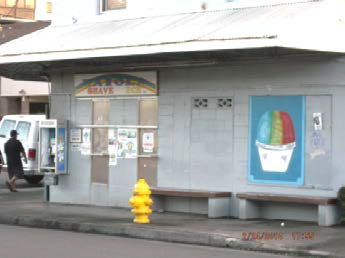 There were questions on how to create places for people to socialize, especially for the younger generation. It was felt that making all facilities wheelchair or stroller accessible would increase and enhance physical and social activity at the various venues. Parking could also be improved.
There were questions on how to create places for people to socialize, especially for the younger generation. It was felt that making all facilities wheelchair or stroller accessible would increase and enhance physical and social activity at the various venues. Parking could also be improved.
Most of the participants (60%) agreed with the statement, “McCully-Mōʻiliʻili residents have opportunities to contribute their skills, knowledge, and time to support the economic prosperity”. Although this section was not thoroughly addressed, there were observations of successful businesses -- small mom and pop stores (Waioli Shave Ice, Laundromat, etc.), large chains (CVS Longs, McDonald’s, etc.), and small business retailers/services/restaurants congregated into shopping plazas (McCully Shopping Center, retail space along Beretania and King streets.) There are also some service oriented jobs at schools, community centers, parks, etc. However, people were concerned about numerous vacant store fronts and sustainability of small businesses that make McCully-Mōʻiliʻili an interesting and vibrant community. There was some discussion about assistance for small businesses to survive.
III. Service Environment
Participants were asked whether “People in McCully-Mōʻiliʻili are well-informed and are able to obtain relevant information on programs and services in the community”. The majority (80%) of the participants disagreed with this statement. It was recognized that there is signage around the community (schools, fire station, community gardens, etc.) which provide information on various programs and services. Posting announcements convey to community residents the events and services available and allows people to be active socially if desired.
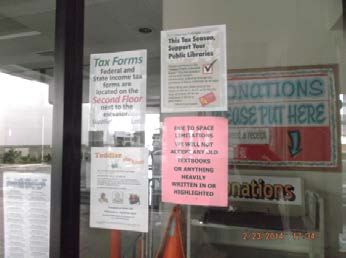 It was felt that language is a barrier especially for the large immigrant population that has grown due to lower rent costs in the area. Citing the diversity of Kuhio School students with approximately 29 ethnic groups, it was suggested that signage and other communications should be in several languages, not just English.
It was felt that language is a barrier especially for the large immigrant population that has grown due to lower rent costs in the area. Citing the diversity of Kuhio School students with approximately 29 ethnic groups, it was suggested that signage and other communications should be in several languages, not just English.
Participants agreed that those who are new to the community wouldn't know much about the community. People who were long-time residents would be more familiar with the history and current programs or services. They wondered how people learn about these if it is not more visible and whether communication on a broadband is readily available and adequate.
The participants were split 45% agreed and 54% disagreed with the statement, “In McCully-Mōʻiliʻili, community supports and services (including health services) are available and accessible to all residents”. Participants felt that many services are available, but residents don’t know about them. For example if you can “see” them, such as Kapiolani Hospital, parks (keiki through senior programs), McCully-Mōʻiliʻili Library, Mōʻiliʻili Community Center (Keiki Care/Adult Day Care/Meals on Wheels), Japanese Cultural Center, Longs Drug Store (pharmacy, health clinic), Japanese Cemetery, Post Office and mail boxes, Laundromat, McCully Shopping Center, or local business plazas on King and Beretania streets, then they are well-utilized. It was felt that ramps, railings, handicap access are needed to help people easily enter/exit buildings and maintenance is necessary for accessibility and improved usage.
 Kapiolani Hospital, Longs Minute Clinic, and to a lesser extent the Fire Station were mentioned as providing health services. Some private physicians and dentists are located in the community. But, no emergency services are available.
Kapiolani Hospital, Longs Minute Clinic, and to a lesser extent the Fire Station were mentioned as providing health services. Some private physicians and dentists are located in the community. But, no emergency services are available.
At convenience stores people can purchase food and a variety of other goods. The locations make it is easy to obtain services and people don’t need to walk as far. Neighborhood grocery stores increase food options. People mentioned that it was sad to see Star Market and a farmer’s market disappear. Besides a weekly open market (which some people didn’t know about), fresh produce and other food choices have become more difficult to obtain.
People talked about the lack of services to address the homeless, the older generation, and low income residents. There was discussion regarding the diversity of services for the population and whether people had to go outside the community to obtain what they needed.
What are the Priorities in Creating an Age-Friendly McCully-Mōʻiliʻili?
Physical Environment
- Create continuity/connectivity between the sidewalks, crosswalks, traffic signals. This could include more crosswalks, more traffic signals, clear and well-defined pedestrian pathways or sidewalks, good signage, and Barnes Dance for large intersections
- Make safety a priority regardless of the target population (elderly or keiki)
- Insure that housing is affordable for people with low or fixed incomes
Social Environment
- Make better use of the Hawai'ian Homelands Bowl-O-Drome property. Ideas included a multi-purpose complex with affordable housing for seniors, recreational facilities, place for concerts, restaurants, and shops
- Utilize existing resources and services that can provide for many residents (e.g., high-rise next to a park) – this could put people in close proximity to parks/green space
- Create places for people such as the younger generation to meet and socialize
Service Environment
- Inform people about available resources
- Encourage private businesses to locate in our community, but they must also integrate
- Hold on to community assets
Overall Priorities
- Set-up planning and goal-setting meetings to discuss if we want an age-friendly community
- Examine using the infrastructure and what the impact will be
Acknowledgements
Special thanks to Ron Lockwood, Neighborhood Board #8 chairperson as well as Iolani High School One Mile Project students and instructors (Allison Blakenship and Kirk Uejio). We also would like to thank to the following people for their contributions: MAPPers (Ane Aga, Antonia Agbannawag, Richert Au Hoy, Larke Golaski, Kellie Kong, Tim Streitz, and Emmanuel Zibakalam), Mark Araiza, Brian McMaster, Ramona Mullahey, Rod & Suzanne Hee, and Kelly Roberts as well as Deborah John of the Oregon State University Extension Service for sharing engAGE in Communities project as well as providing training and technical assistance to develop HI-CFL.
References
Hamai, T. (2014). One-Mile Project; One Planet Community, Generations Magazine. Retrieved April 27, 2014 from http://www.generations808.com/fm2014i.html
Honolulu Star-Bulletin (1996). Places of the heart for everyone. Retrieved April 17, 2014 from http://archives.starbulletin.com/96/10/24/features/story1.html
John, D.H. & Gunter, K. (2012). engAGE in Community, Northwest Public Health, 29, 10-11.
John, D.H., Gunter, K.B., Etuk, L., & Trost, K.K. (2012). GROW Healthy Kids and Communities HEAL MAPPS™ Toolkit Manual. Corvallis, OR: Oregon State University.
Transit-Oriented Community Based Project: McCully Mōʻiliʻili Community Profile (2007)
U.S. Census (2010). 2010 Census Demographic Profile: Oʻahu Census Tract. Retrieved November 12, 2013 from http://census.hawaii.gov/Census_2010/demographic/demo_profile_ct_Oʻahu/
World Health Organization (2007) GlobalAge-Friendly Cities: A Guide
World Health Organization (2007) Checklist of Essential Features of Age-Friendly Cities
Download this report